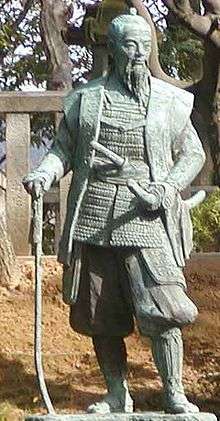Takeda Kōunsai
Takeda Kōunsai (武田耕雲斎, 1803 – March 1, 1865) was a Japanese samurai from Mito Domain and councillor to Mito daimyō Tokugawa Nariaki in Bakumatsu period Japan. He became the leader of the Mito Rebellion and was executed by the Tokugawa shogunate with a large number of his followers shortly before the Meiji Restoration.
Takeda Kōunsai | |
|---|---|
 Takeda Kōunsai statue in Tsuruga | |
| Native name | 武田耕雲斎 |
| Born | 1803 Mito Domain, Japan |
| Died | March 1, 1865 (aged 61–62) Tsuruga, Fukui, Japan |
| Buried | [ |
| Allegiance | Mito Domain |
| Battles/wars | Mito Rebellion |
| Relations | Hijikata Yoshiatsu (father) Etsu (mother) |

Biography
Although Takeda Kōunsai claimed descent from the famous Takeda clan of Kai Province, his immediate ancestor was a Takeda retainer named Atobe Katsusuke, and his claimed connection with the Takeda clan is somewhat tenuous. In 1817, when he inherited his father's 300 koku fief, he changed his surname from Atobe Hikokuro (跡部彦九郎) to Takeda Masaki (武田正生).
As a senior advisor to Tokugawa Nariaki, he helped formulate the reforms to the administration and policies of the Tokugawa shogunate that Nariaki was attempting to promote. These included strengthening the shogunate's military forces and to take aggressive action against the foreign warships encroaching on Japan's territorial waters and threatening its policy of national isolation. However, Nariaki was forced to retire in 1844 by the Tairō Ii Naosuke. Following Ii's assassination, Nariaki returned to national politics, where he railed against the weak response the shogunate made with regards to the Perry Expedition of 1853 and the subsequent signing of the Convention of Kanagawa and the Harris Treaty over the objections of Emperor Kōmei. Takeda Kōunsai emerged during this period as a leader of the increasingly radical pro-sonnō jōi faction within Mito Domain, which started a campaign of terrorist attacks on foreigners in Japan and assassination of Japanese officials supporting the shogunate. Events came to a head from May 1864 to early 1865 with the Mito Rebellion, where a force of some 700 Mito samurai armed with firearms and cannon and 1300 partisan insurgents battled an shogunal army of 3000 troops on the slopes of Mount Tsukuba, Nakaminato and other locations.
Takeda Kōunsai attempted to go directly to Kyoto to appeal to the imperial court, but was captured in Tsuruga with his 823 of remaining followers. The rebels were held by the shogunate in 16 herring storehouses by the port under very poor conditions in the middle of winter, and many died. The following year, 353 of the survivors, including Kōunsai, were taken to the temple of Raiko-ji and were executed en masse. Shogunal authorities later arrested and executed his widow, two sons and three grandchildren.
Grave of Takeda Kōunsai
Following the Meiji restoration, the temple of Raiko-ji became a Shinto shrine, Matsubara Jinja, wherein the 411 members of the Mito Rebellion who died in Tsuruga (including those who died in prison) are commemorated as kami. The mass graves of Takeda Kōunsai and his 353 followers were in five mounds within the precincts of the former temple, and the new Meiji government amalgamated the mounds into a single 30 x 4 meter mound, upon which 15 gravestones made from stone from Mito were arranged in a "U"-shape in 1868.
In 1954, in commemoration of the 90th anniversary of the Mito Rebellion, one of the herring storehouses was moved to the grounds of Matsubara Jinja and became the Mito Rebellion Patriots’ Museum.
The graves of Takeda Kounsai and his followers is designated as a National Historic Site by the Japanese government in 1976. [1]
Notes
- "武田耕雲斎等墓" (in Japanese). Agency for Cultural Affairs.
External links
- Tsuruga Tourist Association (in Japanese)